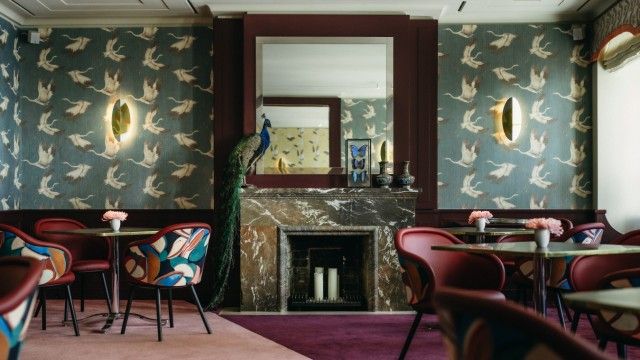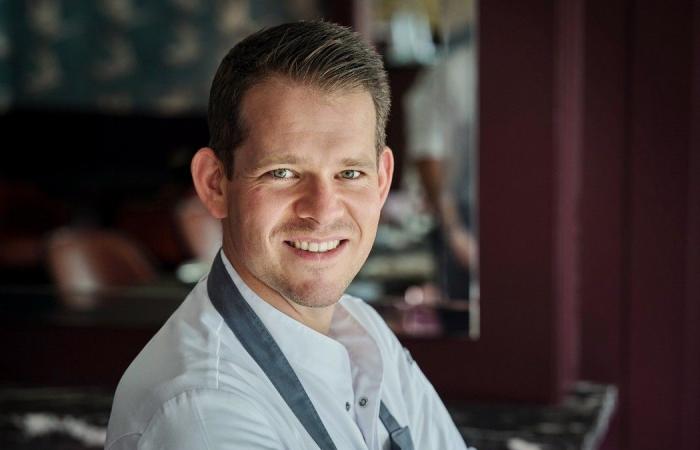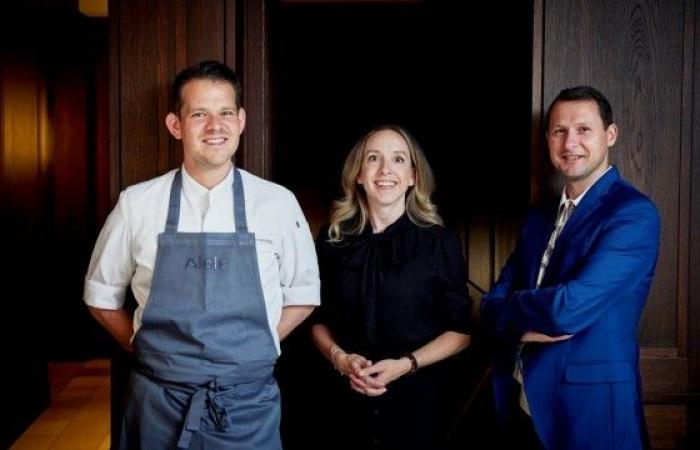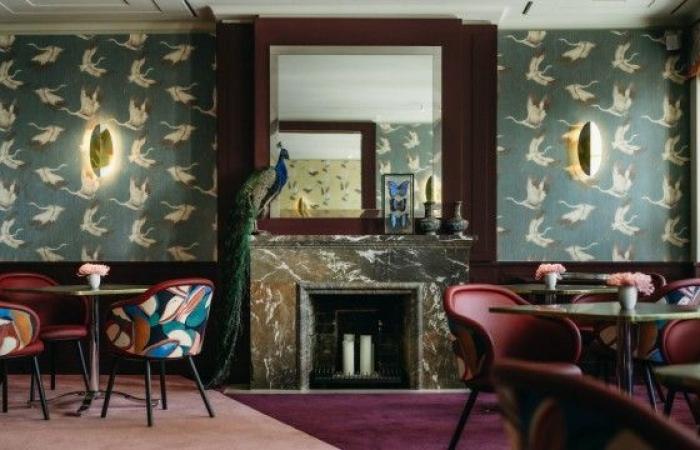It’s quite possible that it was the raw sea urchin with pumpkin spaghetti and bright yellow saffron, pumpkin and sea buckthorn sauce that made Florian Randlkofer so convinced that he had reached his goal. That he had finally found the chef he had been looking for for so long. Or was it the char in buttermilk and chives sauce that his wife Sunny liked so much? It could also have been the choux pastry fritters with chicken liver and currant yoghurt. It doesn’t matter, at some point on that January evening in the small hamlet of Zug near Lech am Arlberg, the two suspected that they were sitting at the table with the man in whose hands they wanted to place the future of their gourmet restaurant “Alois”. “For us, he’s absolutely the ideal choice,” says Randlkofer.
For more than half a year, there was a lot of guesswork about the restart in one of Munich’s most ambitious restaurants. Now the head of the Dallmayr delicatessen has lit a little bomb: Max Natmessnig, 34 years old, will be the head chef at “Alois” from October 1st. A name that no one had on their radar – although the native of Lower Austria was named Chef of the Year 2022 by the Austrian Gault Millau for his highly creative menus at “Chef’s Table Rote Wand” in Lech and Forbes recognized his performance as one of the “Ten Coolest Restaurants 2021” listed. In Germany, however, he was previously only known to insiders. That will change quickly. Natmessnig has a lot of potential and ambition. He will shake up the Munich gourmet scene and will probably quickly attract attention nationwide. Because he not only has culinary intelligence, but is one of the still rare talents in German-speaking countries with international experience.
“For us, he’s absolutely the ideal choice”: Dallmayr bosses Sunny and Florian Randlkofer are enthusiastic about Max Natmessnig’s (left) cooking skills.
(Photo: David Maupile)
In any case, in the stylish “Alois” with a view of the Frauenkirche, a few things will change from October 20th, the opening day. Natmessnig is not only bringing his wife Rebekah with him – she will run the restaurant together with the established Julien Morlat – but also three chefs and a new concept: in future a so-called chef’s table menu will be served. In other words, a fixed menu of many small courses, which the chef brings to the tables himself time and time again, thus engaging in an intensive dialogue with his guests.
A program as you know it from your time in Lech. Anyone who has visited him there knows that the most surprising thing about Natmessnig’s menu is that, despite the 18 small courses, it can also be managed by stomachs with a smaller capacity. Thanks to a meticulously sophisticated play of aromas, the absence of heavy sauces and, to a large extent, carbohydrates, you won’t feel weighed down at the end of the evening. Dallmayr guests can look forward to a culinary tour de force that has a lot to do with the chef’s wealth of experience, which is amazing for his age.
His goal: to create purism with the best products in the world
Natmessnig’s CV reads like a who’s who of top gastronomy: After leaving school, tourism college and internship in France, he ended up with Heinz Reitbauer in Vienna’s “Steirereck”, Austria’s culinary hotbed. From there it went on to the exceptional Dutch chef Sergio Herman. There he stayed for three years in his (now closed) three-star restaurant “Oud Sluis” to “learn what perfection means on the plate”. He then spent a year in New York in Daniel Humm’s second restaurant, another superstar in the culinary universe, and finally came the change to the “Chef’s Table at Brooklyn Fare”, probably his most formative station. The small restaurant of the self-confessed product fetishist César Ramirez (three stars) is fully booked year in, year out for months. “The plane came from Tokyo three times a week,” recalls Natmessnig. The young Austrian was fascinated by the ultra-fresh goods from the local fish market and the fruit, which was embedded in cotton wool like precious jewellery: “I learned how to use the best products in the world to produce what is most difficult in the kitchen: purism in the kitchen Plate.”
One evening, the hotelier Joschi Walch from Lech took a seat at César Ramirez’ chef’s table, where the guests sit around a kind of fine counter and are in constant dialogue with the chefs. A few days later, Natmessnig had his first job as a chef in his pocket. With his American wife, he moved from Brooklyn to the 1,600-strong community of Lech am Arlberg. There is a chef’s table there too, but the contrast couldn’t be greater: it’s in the ‘Schualhus’, a better 17th-century wooden hut where children were educated well into the 20th century. Low wooden ceilings, a creaking staircase to the first floor, a wooden counter for 14 guests (which was always sold out twice per evening), the scent of spruce wood – an alpine idyll and so very different from the workplace in the American metropolis. After eight years abroad, the young head chef plunged into the alpine product world of Vorarlberg – and discovered the fascination of char from the crystal-clear Lech, chanterelles he collected himself and sourdough bread baked according to old traditions.

Dignified atmosphere with modern furnishing elements: This is what the new gourmet restaurant “Alois” looks like.
(Photo: David Maupile)
In the tension between his New York experiences, Japanese influences and the exchange with small producers in the Alpine region, Natmessnig developed the concept that he is now bringing to Munich in a modified form: a menu that is a bit like a theater performance and the guest from the first to keep you in suspense until the last moment. Some of his Arlberg classics will move with him, for example the trout tartare on meringue with horseradish mousse and lime or the aforementioned char, one of his signature dishes. The Fuji-San bread, which was always served at the end in Lech, is also coming to Munich. “I ate a similar bread on our honeymoon in Hokkaido,” says the chef. His version is a very fluffy Japanese milk bread served with coconut caramel with coffee.
Natmessnig’s kitchen is like himself: focused and unfussy. “We’re concentrating on one main product,” he says, “that’s prepared in an authentic way.” Some of his creations look downright simple on the plate, but have enormous aromatic depth. The newcomer will liven up the Munich scene, but also challenge it. Some internationally quite common customs still have to be enforced in Germany: For example, that the guests have the choice of three “slots”, fixed times at which they – and punctually – should appear in the restaurant. There is a reason for this: Natmessnig personally greets a small group of guests and briefly introduces his ideas and product world to them, shows dried Moroccan lime, Spanish deep-sea shrimp and finely marbled Tyrolean XO beef. Something like this can only be done in the tightly scheduled service if everyone sticks to the time limit.
Rebekah Roberts-Natmessnig takes care of the right drinks – without alcohol
The idea of offering alcohol-free accompaniment for each individual course is still relatively new for Munich’s top gastronomy. This is what Rebekah Roberts-Natmessnig stands for, who, as a trained chef, creates many of the innovative drinks herself and matches them precisely to the aromatic nuances of the dishes – for example plum juice, which she refines with Japanese dashi and medlar vinegar. If you prefer to stay with the wine in view of the impressive Dallmayr cellar, you should stick to Julien Morlat. The native Frenchman, known to guests of the house as a charming host for many years and one of the most accomplished sommeliers in the city, is now, so to speak, the personified connection between the old and the new “Alois”.
The replacement in “Alois” represents the ambition of the Randlkofer family to play at the top of the German table in the future. But also for a development that has been on the Isar for a year or two: up until the 1990s, Munich was considered the leading gourmet metropolis in Germany. With Max Natmessnig in “Alois”, Benjamin Chmura in “Tantris”, Tohru Nakamura with his “Skripterei” and soon also Jan Hartwig in his own restaurant “Jan”, a young generation of chefs is ready to build on this enjoyable tradition.





